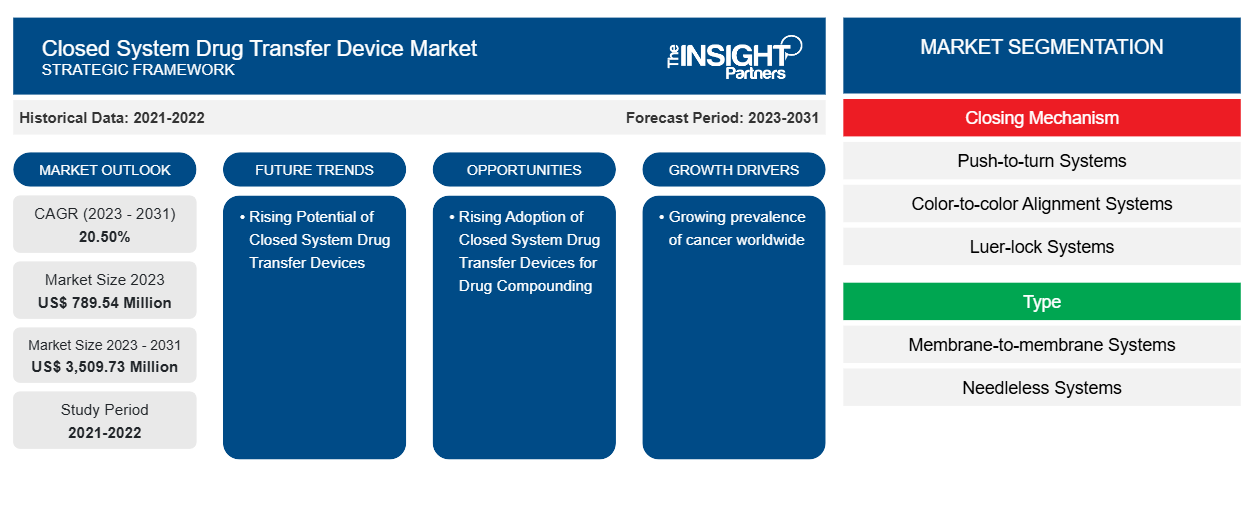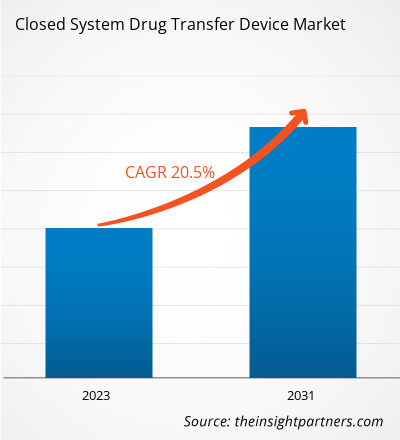The Closed System Drug Transfer Device Market size is projected to reach US$ 3,509.73 million by 2031 from US$ 789.54 million in 2023. The market is expected to register a CAGR of 20.50% in 2023–2031. The increasing awareness related to the risk associated with hazardous drugs, particularly in healthcare settings such as hospitals and pharmacies, rising chronic as well as acute diseases along with integration of digital health services for improved monitoring and safety compliance is likely to remain key Closed System Drug Transfer Device market trends.
Closed System Drug Transfer Device Market Analysis
The adoption of closed system transfer devices is increasing rapidly, due to major factors such as the rising prevalence of cancer, and implementation of CSTDs for transporting hazardous medications, the need for monitoring compliance for the safe management of injurious drugs, and the escalating quantity of drug sanctions for cancer. For instance, in 2023, approximately 1,958,310 new cancer cases and 609,820 cancer deaths were likely to befall in the US. Hence, the adoption of CSTD will increase owing to its rising prevalence. Moreover, these devices support circumventing environmental contamination with damaging drugs resulting in increased device adoption, which in turn, further propel the overall closed system drug transfer device market.
Closed System Drug Transfer Device Market Overview
North America is the largest market for Closed System Drug Transfer Device market growth with the US holding the largest market share followed by Canada. Rapid technological development in the medical device industry, adoption of CSTD for various diseases, and presence of regulatory guidelines related to CSTD and its implementation in healthcare facilities For instance, The National Institute for Occupational Safety and Health (NIOSH) recommends healthcare workers to use a CSTD throughout the hazardous drug-handling chain, from pharmaceutical compounding to patient dose administration. Such established regulatory guidelines are driving the market growth of the North American CSTD market.
Customize This Report To Suit Your Requirement
You will get customization on any report - free of charge - including parts of this report, or country-level analysis, Excel Data pack, as well as avail great offers and discounts for start-ups & universities
Closed System Drug Transfer Device Market: Strategic Insights

-
Get Top Key Market Trends of this report.This FREE sample will include data analysis, ranging from market trends to estimates and forecasts.
Closed System Drug Transfer Device Market Drivers and Opportunities
Rising Adoption of Closed System Drug Transfer Devices for Drug Compounding Favors the Market
A study conducted by International Environmental Research and Public Health in July 2021, studied the effectiveness of closed-system drug transfer devices (CSTDs) was studied for reducing leakage during antineoplastic drug compounding. The Equashield II closed system was used to effectively eliminate spills and leakage during gemcitabine compounding. Since drugs with different viscosities can have different effects on CSTDs, Equashield II needs to be considered with other antineoplastic drugs. Hence, the rising adoption of these devices for antineoplastic drugs creates an opportunity for market growth to flourish in the coming years.
Rising Potential of Closed System Drug Transfer Devices in Emerging Economies– An Opportunity in Closed System Drug Transfer Device Market
Technological advancements in medical devices and rapid Innovations in CSTD represent another major growth-inducing factor. With those advancements, there exists a huge opportunity in emerging markets with high potential are present due to improved healthcare infrastructure, an increase in unmet healthcare needs, and a rise in the prevalence of cancer. The availability of various facilities providing CSTD procedures is an emerging opportunity for the key players in the market to invest in CSTD, and thus it is anticipated to accelerate the market expansion.
Closed System Drug Transfer Device Market Report Segmentation Analysis
Key segments that contributed to the derivation of the Closed System Drug Transfer Device Market analysis are closing mechanism, type, technology, component, and end user.
- Based on the closing mechanism, the Closed System Drug Transfer Device market is segmented into Push-to-Turn Systems, Color-to-Color Alignment Systems, Luer-lock Systems, and Click-to-lock Systems. The Color-to-Color held a larger market share in 2023.
- By Type, the market is segmented into Membrane-to-membrane Systems and needleless Systems. The membrane-to-membrane segment held the largest share of the market in 2023. Advancement in membrane-to-membrane CSTD devices ensuring safe and efficient transfer of fluids and medication is driving the growth of this segment.
- Based on the technology, the Closed System Drug Transfer Device market is segmented into Diaphragm-based Devices, Compartmentalized Devices, and Air Cleaning/Filtration Devices. The diaphragm-based device segment held the largest share of the market in 2023. Diaphragm-based CSTD enhanced reliability and its increasing application in healthcare settings.
- Based on the component, the Closed System Drug Transfer Device market is segmented into Vial Access Devices, Syringe Safety Devices, Bag/Line Access Devices, and Accessories. The vial access devices segment held the largest share of the market in 2023, as it ensures the drug transfer integrity of the drug transfer process with closed systems.
- By end user, the market is segmented into hospitals, clinics, oncology centers, and other end users. Hospitals and Clinics held the major share in 2023, as they serve as the primary point of contact for patients requiring a wide range of medical procedures and treatments requiring safety measures to be followed.
Closed System Drug Transfer Device Market Share Analysis by Geography
The geographic scope of the Closed System Drug Transfer Device Market report is mainly divided into five regions: North America, Asia Pacific, Europe, Middle East & Africa, and South America/South & Central America.
North America has dominated the Closed System Drug Transfer Device Market. The market growth can be attributed to the technological innovation in the medical device sector, rising focus on occupational health safety hazards, and stringent government regulation for the adoption of CSTD in healthcare facilities for safe medical practices in North America. The presence of major market players in this region involved in strategic initiatives is another driving factor for the North American closed-system drug transfer devices market.
Closed System Drug Transfer Device Market Regional InsightsThe regional trends and factors influencing the Closed System Drug Transfer Device Market throughout the forecast period have been thoroughly explained by the analysts at The Insight Partners. This section also discusses Closed System Drug Transfer Device Market segments and geography across North America, Europe, Asia Pacific, Middle East and Africa, and South and Central America.
Closed System Drug Transfer Device Market Report Scope
| Report Attribute | Details |
|---|---|
| Market size in 2023 | US$ 789.54 Million |
| Market Size by 2031 | US$ 3,509.73 Million |
| Global CAGR (2023 - 2031) | 20.50% |
| Historical Data | 2021-2022 |
| Forecast period | 2023-2031 |
| Segments Covered |
By Closing Mechanism
|
| Regions and Countries Covered |
North America
|
| Market leaders and key company profiles |
|
Closed System Drug Transfer Device Market Players Density: Understanding Its Impact on Business Dynamics
The Closed System Drug Transfer Device Market is growing rapidly, driven by increasing end-user demand due to factors such as evolving consumer preferences, technological advancements, and greater awareness of the product's benefits. As demand rises, businesses are expanding their offerings, innovating to meet consumer needs, and capitalizing on emerging trends, which further fuels market growth.

- Get the Closed System Drug Transfer Device Market top key players overview
Closed System Drug Transfer Device Market News and Recent Developments
The Closed System Drug Transfer Device Market is evaluated by gathering qualitative and quantitative data post primary and secondary research, which includes important corporate publications, association data, and databases. The following is a list of developments in the market for Closed System Drug Transfer Devices:
- EQUASHIELD, a pioneer in closed system transfer devices (CSTDs) and automated pharmacy compounding solutions announced its remarkable achievement of being named by the Pharmacy Purchasing & Products as the most used device in the preparation and administration of hazardous drugs for five consecutive years. (Source: Equashield, Press Release/Company Website/Newsletter, August 2022)
- B. Braun Medical Inc., a leading provider of closed system transfer devices (CSTD), announced today that the OnGuard 2 CSTD is now available in the United States. OnGuard 2 incorporates all of the current advantages of OnGuard, while offering upgraded materials and enhanced features to improve its usability. (Source: B. Braun Medical Inc, Press Release/Company Website/Newsletter, December 2021)
Closed System Drug Transfer Device Market Report Coverage and Deliverables
The “Closed System Drug Transfer Device Market Size and Forecast (2022–2030)” report provides a detailed analysis of the market covering below areas:
- Market size and forecast at global, regional, and country levels for all the key market segments covered under the scope
- Market dynamics such as drivers, restraints, and key opportunities
- Key future trends
- Detailed PEST/Porter’s Five Forces and SWOT analysis
- Global and regional market analysis covering key market trends, major players, regulations, and recent market developments
- Industry landscape and competition analysis covering market concentration, heat map analysis, prominent players, and recent developments
- Detailed company profiles
- Historical Analysis (2 Years), Base Year, Forecast (7 Years) with CAGR
- PEST and SWOT Analysis
- Market Size Value / Volume - Global, Regional, Country
- Industry and Competitive Landscape
- Excel Dataset
Recent Reports
Related Reports
Testimonials
Reason to Buy
- Informed Decision-Making
- Understanding Market Dynamics
- Competitive Analysis
- Identifying Emerging Markets
- Customer Insights
- Market Forecasts
- Risk Mitigation
- Boosting Operational Efficiency
- Strategic Planning
- Investment Justification
- Tracking Industry Innovations
- Aligning with Regulatory Trends





















 Get Free Sample For
Get Free Sample For